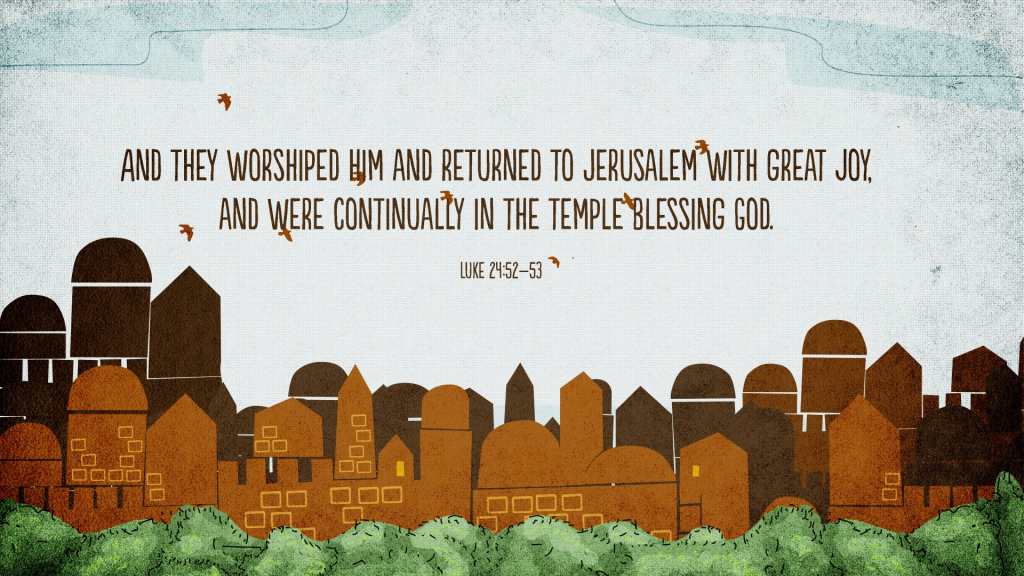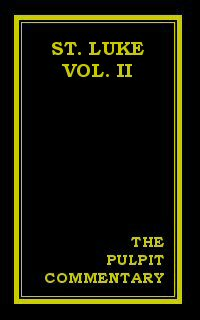

One of the largest homiletical commentary sets of its kind, this work gives a verse-by-verse exposition, a translation, and historical and geographical information, followed by the homiletics section, homilies by numerous authors, and a homiletical index to the Bible.
Ver. 52.—And they worshipped him, and returned to Jerusalem with great joy. This “great joy,” on first thoughts, is singular till we read between the lines, and see how perfectly they now grasped the new mode of the Lord’s connection with his own. They knew that henceforth, not for a little time as before the cross, not fitfully as since the Resurrection, but that for ever, though their eyes might not see him, would they feel his blessed presence near (see John 14:28; 16:7).
One question more connected with the Ascension presses for an answer. Much modern criticism regards this last scene simply as one of the ordinary disappearances of the forty days, and declines to admit any external, visible fact in which the Ascension was manifested. But St. Luke’s description, both in his Gospel and in the Acts, is plainly too circumstantial to admit of any hypothesis which limits the Ascension to a purely spiritual elevation. At the end of his earthly ministry, the evening before the cross, Jesus asked back his glory: “Now, O Father, glorify thou me with thine own self, with the glory which I had with thee before the world was” (John 17:5).
The Ascension and consequent session at the right hand was the answer to the prayer of Christ. It was necessary for the training of the first teachers of Christianity that the great fact should be represented in some outward and visible form. “The physical elevation,” writes Dr. Westcott, “was a speaking parable, an eloquent symbol, but not the truth to which it pointed, or the reality which it foreshadowed. The change which Christ revealed by the Ascension was not a change of place, but a change of state; not local, but spiritual.
Still, from the necessities of our human condition, the spiritual change was represented sacramentally, so to speak, in an outward form.… He passed beyond the sphere of man’s sensible existence to the open presence of God” (‘The Revelation of the Risen Lord’). The session at the right hand of God (Mark 16:19) cannot designate any particular place. The ascension, then, of Jesus is not the exchange of one locality, earth, merely for another we term heaven. It is a change of state; it is a passing from all confinement within the limits of space to omnipresence.
Ver. 53.—And were continually in the temple, praising and blessing God. Amen. These last words of the Gospel just alluded to the life of the first teachers, which is dwelt upon with considerable detail in the Acts. In the early days which succeeded the Ascension, the temple and its courts were the principal resort of the teachers of the new “way.” We know that in an extraordinarily short time the numbers of adherents to the crucified and risen Jesus, in Jerusalem only, were counted by thousands.
The temple and its vast courts, from its storied past, from its having been the scene of much of the Master’s last teaching, was the natural centre for these leaders of the new “way.” When Luke wrote the words,“were continually in the temple,” it is almost certain that he proposed continuing his great narrative in the book we know as the Acts of the Apostles, in which, guided by the Divine Spirit, he relates to us how the Lord Jesus continued to work on earth—in and by his Church—from his glory-throne in heaven.
The early chapters of the Acts take up the thread of the gospel story, and describe the life and work of the friends of Jesus in the great Jerusalem temple, the dangers they had to encounter, and the splendid success which rewarded their brave, faithful toil. These same Acts, in the first lines of their thrilling story, take up again the Ascension scene, which is described with fresh and vivid details. From these details we learn how, when the disciples’ eyes were fixed on that cloud which veiled their ascending Master, they became aware of two stranger-forms with them, clad in white and glistening garments.
They knew these belonged to no earthly company. They were two among the thousands of thousands of angels, possibly the angels of the Resurrection, who sat in the empty garden-tomb. These angels tell the awe-struck friends of the ascended Jesus that their adored Master will one day (Acts 1:2) come back to earth in like manner as they had seen him go to heaven.
“O earth, thou grain of sand on the shore of the great ocean of the universe of God, thou Bethlehem among the princes of the regions of heaven, thou art and thou ever wilt be, among ten thousand times ten thousand suns and worlds, the loved one, the elect of the Lord; thee will he visit again; thou shalt provide him a throne, even as thou gavest him a manger; thou shalt rejoice in the splendour of his glory, even as thou drankest his blood and his tears, and mournedst at his death. On thee he hath a great work yet to accomplish” (Häfeli, quoted by Stier).
Spence-Jones, H. D. M., ed. (1909). St Luke (Vol. 2, p. 278). Funk & Wagnalls Company.